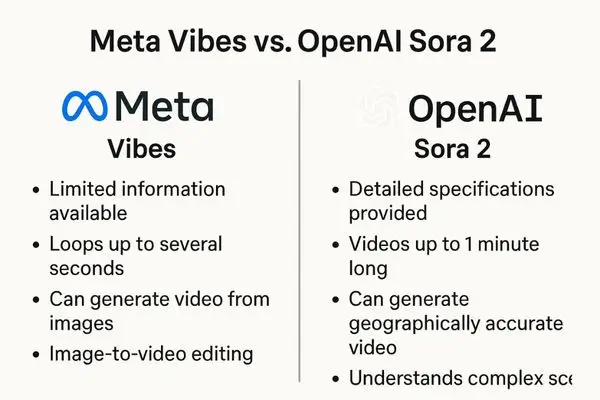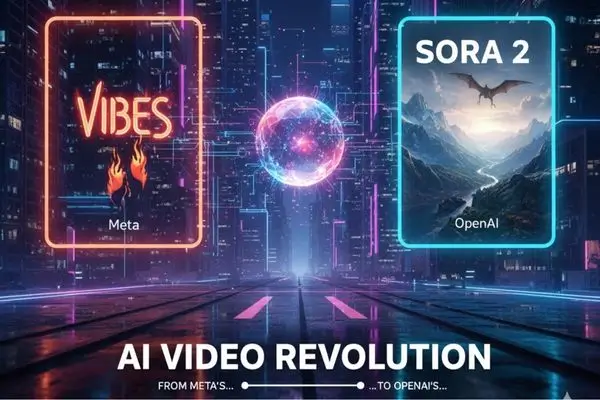AI Video Revolution: You’re scrolling TikTok, but instead of endless dance challenges and cat fails, you’re watching a figure skater nailing a triple axel with a fluffy cat perched on her head. Or a guy galloping on a horse… that’s literally riding another horse.
Table of Contents
Sounds like a fever dream? Welcome to the wild new world of AI-generated videos, where your wildest (or weirdest) ideas can spring to life in seconds.
In late September 2025, Meta’s Mark Zuckerberg dropped “Vibes,” a free tool letting anyone whip up AI videos from simple prompts. Not to be outdone, OpenAI fired back with Sora 2 – an invite-only powerhouse that’s already dominating Apple’s App Store charts.
As a tech blogger who’s spent way too many hours testing AI tools (guilty as charged), I dove deep into these game-changers. They’re not just fun party tricks; they’re reshaping social media, entertainment, and even how we spot “real” from “fake.”

But with great power comes… well, a tidal wave of deepfakes and “AI slop.” Stick around – I’ll break it all down, share pro tips for creators, and flag the red flags so you can jump in smartly.
See Also: Technology Solutions Professional: Guide + 5 Key Responsibilities
AI Video Revolution: How Sora 2 is Democratizing Video Magic
Let’s start with the buzz. Meta’s “Vibes” is like a creative playground on steroids – users describe scenes in plain English, and poof! AI spins out hyperrealistic or totally fantastical clips. Want a dragon barista serving lattes in a cyberpunk café? Done.
Zuckerberg’s vision? Lower the bar so everyone – not just pros with Final Cut Pro – can create.
Then there’s OpenAI’s Sora 2, the sequel to their viral text-to-video model. It’s exclusive (invite-only for now), but that’s only amped the hype. Users can craft videos starring “cameos” of themselves or friends (with permission, of course), turning personal stories into mini-movies. OpenAI’s demo reel? Gold. Prompts like “a man rides a horse which is on another horse” yield seamless, quirky animations that feel straight out of a Pixar short – but generated in minutes.
Hany Farid, UC Berkeley’s go-to expert on digital forensics, nails it: “You’re only limited by your imagination.” These tools aren’t clunky beta tests; they’re polished enough for non-experts to produce content that rivals Hollywood polish.
Pro tip for newbies: Start simple. Try Sora 2’s free tier with prompts under 20 words – focus on action over adjectives to avoid wonky results.
TikTok on AI Steroids: The Social Media Shake-Up
Forget passive scrolling – these apps are turning feeds into interactive story factories. “Vibes” mimics TikTok’s addictive loop, but every video is AI-born. Adam Nemeroff, Quinnipiac University’s tech whiz, predicts Meta will blend Vibes content right into your Instagram or Facebook feed alongside human-made stuff. “Meta’s all about attention,” he says. “Why not supercharge it with endless AI variety?”
Sora 2 takes it further with personalized cameos, letting you “star” in surreal skits with buddies. It’s a dream for influencers: Quick, cheap content that hooks viewers.
But here’s the engagement hack – watermark your AI vids (both tools do this automatically) and tag them #AIVibes or #SoraMagic. It builds authenticity while riding the trend wave.
The upside? A creative boom for educators (think animated history lessons) and small businesses (product demos on a budget). The flip? Feeds flooded with low-effort “slop” – think endless cat-riding-horse loops diluting quality shares.
The Money Game: Free Now, Paywalls Later?
Both apps launch free, but don’t get too cozy. OpenAI’s teasing a “pay a bit for extra renders” model if servers melt under demand – smart, given compute costs rival small data centers. Meta? Keeping Vibes gratis for now, per their spokesperson, but Nemeroff bets on ads and brand tie-ins soon. Imagine sponsored cameos: “Watch this horse-riding tutorial brought to you by [Energy Drink].”
For creators, this means early adoption wins. Grab a Sora invite via OpenAI’s waitlist (tips: Follow their X account and engage – it boosts odds). Once monetized, expect affiliate vibes: Tools like these could spawn a new creator economy, where AI videos rake in affiliate bucks from embedded product placements.

The Dark Side: Deepfakes, Slop, and Safeguards – What You Need to Know
Excitement aside, experts like Farid are waving red flags. “Anybody with a keyboard can create videos of anyone saying or doing anything,” he warns. Enter “AI slop” – that flood of mediocre, misleading clips cluttering your feed. Meta’s cross-posting Vibes to Facebook Stories? Recipe for chaos, as Nemeroff notes: “It distracts from reputable info, popping up right next to real news.”
Deepfakes are the real nightmare – fabricated vids that erode trust. But both companies are stepping up:
- OpenAI’s Sora 2: Every video gets visible/invisible “provenance signals” (fancy watermarks) to flag AI origins. They block harmful prompts (e.g., no violence glorification) and let users opt into cameos.
- Meta’s Vibes: Invisible watermarks for traceability, plus “AI Info” labels on posts. A spokesperson emphasized: “We’re empowering expression while building in protections.”
Useful reader tip: Always reverse-image search suspicious vids (try Google’s tool) or check for glitches like unnatural blinks. And creators? Disclose AI use – it builds trust and dodges platform bans.
See Also: Electric Vehicles Demystified: The Ultimate easy Guide
Hollywood’s Reckoning: Disruption Hits the Big Screen
If social media’s evolving, entertainment’s in for a plot twist. Sora 2’s cameo feature? It’s already sparking IP wars. The Motion Picture Association’s Charles Rivkin slammed OpenAI for letting users remix copyrighted characters, putting enforcement on studios’ shoulders. “They must prevent infringement – not us,” he fired back.
Recent drama: Dutch comedian Eline Van der Velden’s AI “actress” debut drew SAG-AFTRA ire, with the union insisting: “Creativity stays human-centered.” Farid sums it up: “Disruption means destruction and creation – hitting movies, music, and beyond.”
For aspiring filmmakers, this is dual-edged: Tools like Vibes lower entry barriers (script-to-screen in hours), but pros demand guardrails. Watch for 2026 regs – EU’s AI Act could mandate clearer labeling, protecting jobs while fostering innovation.
Your Playbook: How to Dive In Without Drowning
Ready to experiment? Here’s a quick-start guide:
- Get Access: Sign up for Sora 2’s waitlist (openai.com/sora) or test Vibes via Meta’s app.
- Prompt Like a Pro: Use vivid verbs – “dramatic sunset chase on a cyber-bike” beats “bike ride.”
- Stay Ethical: Get consent for cameos; watermark everything.
- Monetize Smart: Post to TikTok/Reels with #AIGenerated for viral potential.
- Spot Fakes: Look for audio sync slips or overly perfect lighting.
In a world where AI videos could outnumber human ones by 2027 (per Gartner vibes), these tools are your creative superpower – if wielded wisely.
What’s your first AI video prompt? A cat-axeler or something epic? Drop it in the comments – let’s brainstorm! Hit subscribe for more AI deep dives, and share if this sparked your next big idea. Until next time, keep creating – keep it real(ish).
Sources: CBS News, OpenAI/Meta announcements, expert quotes from Farid
Pingback: Easy Guide to Network Settings in Windows 11